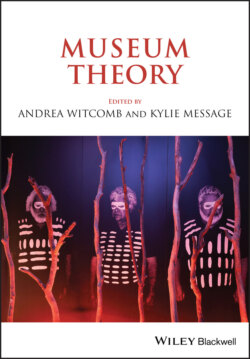Читать книгу Museum Theory - Группа авторов - Страница 38
Conclusion: Seeing in the space of the already said
ОглавлениеWe have, then, three models of the museum in Foucault’s work: the abstract space of changing discourse (Hooper-Greenhill); the disciplinary space of the “open prison” (Bennett); and the space of the infinite and yet monadic archive, which is ambiguously open to both possibility and doubt in its truth claims. Foucault himself was never explicit on any of these positions; he invited all three and perhaps others besides. If the first of these positions, following Deleuze’s criticisms, can be said to place too much emphasis on the formation of discourse in the making of truth at the expense of an understanding of the role of the nondiscursive (materialities) in relations of power, then the second, associated with Discipline and Punish, can be said to rectify that; but it does it in a way that limits the possible diagrammatic expressions of power that do not map neatly onto the panopticon model. Despite Bennett’s extended efforts to persuade us of the nuanced disciplinary effects of the museum (see Chapter 1 in this volume), there is still a reductionism to this function that surely precludes too many other dimensions of the museum’s role within society. The third position, based on a few fragments surrounding Foucault’s “failed” archaeology /archive project (see Dreyfus and Rabinow 1982), suggests more open possibilities (on previous attempts to reconstruct these fragments, see Donato 1979; Crimp 1993; Shapiro 2003). Foucault offers us neither the utopian promise of the museum’s own self-belief nor a model of another carceral institution that shows how it is just another institutionalization of discursive power within the cultural field. Was it lack of interest or an inability to resolve the ambiguous relation between saying and seeing within these spaces that led him to abandon his approach to the cultural institutions of modern art? We shall never know, but we do know that he subsequently sought certainty in the operation of the visual technology of power in the much less ambiguous space of the prison in the work that followed in the early 1970s.
What Foucault offers us instead is another space of power, one defined by an irresolvable tension between establishing the truth in discursive and nondiscursive forms, in which discourses have the opportunity to be both made and unmade by how we see in the realm of discursive power. That he never established a clear position, that he perhaps vacillated in his appreciation of both aspects of the museum and did not articulate a clear understanding of the spaces of culture as he did with madness, health, and prisons, is perhaps because of its inherent ambivalence. As a diagram of power the museum’s lines are never clearly drawn (see Hetherington 1997b). It is even less clear now that it is just a space in which discourses are made or where discipline takes place. It is a space that captures time as history only to see it shift and morph into something else: colonial splendour into slavery, civilization into Orientalism and conquest, Western primacy into doubt, conservation into decay, display into storage. It is an understanding of this movement, and the uncertainty associated with it, that Foucault’s work offers to the study of the museum, resulting in a much more fluid understanding of the shaping of power, in a space of continual emergence, and subjectivity.
